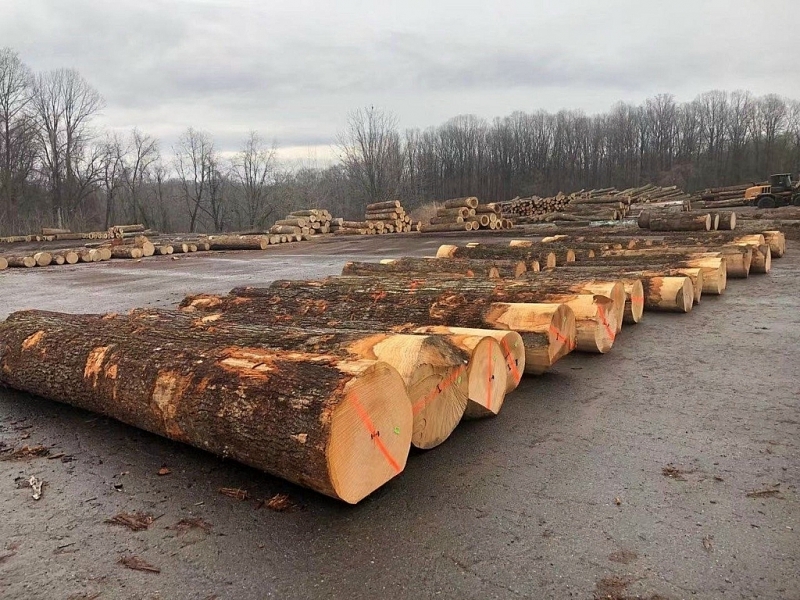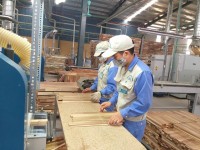| Chinese FDI overwhelming the wood industry, with low investment capital | |
| Controlling the risk of importing wood from China |
 |
| Each year, Vietnam imports about 5-6 million m3 of logs and sawn timber (raw material). Source: Internet |
Imported wood up to US$300/m3
According to the latest calculations of the Research Group of Timber Associations and Forest Trends, based on statistics from the General Department of Customs, in 2021, Vietnam will import over 4.2 million m3 of round timber, which is a low-risk wood according to the criteria of Decree 102/ND-CP stipulating the Vietnam Legal Timber Assurance System, from 44 countries and territories.
Import volume accounted for 72% of the total amount of wood materials imported into Vietnam in the same year.
In 2021, there are 13 countries with a supply of more than 100,000 m3 of low-risk timber from each country for Vietnam. The supply from these 13 sources accounted for over 85% of the total supply of low-risk timber into Vietnam in the same year. The countries with the largest supply include the US, Brazil, Chile, New Zealand, Australia and Belgium.
“With the current growth in exports of about 20%, the demand for imported wood materials used for processing in Vietnam will continue to increase in the future,” said To Xuan Phuc, policy analyst, Forest Trends Organization.
Notably, Phuc added that the Covid-19 pandemic caused a disruption in the supply chains and a scarcity of empty containers. This caused international shipping costs to skyrocket.
Information on the Drewry World Container global freight rate index shows that the freight rate for a 40-foot container has increased from less than $1,500 in July 2019 to nearly $8,500 in July 2021, up nearly 6 times within 5 years.
In addition to rising freight rates, the pandemic also creates a shortage of timber supply in some of the main timber supplying countries for Vietnam, especially for low-risk sources such as the US and European countries.
The stimulus packages and low-interest loans in these countries increased the demand for construction using raw wood. The source of export wood becomes more and more scarce, pushing up the price of raw wood materials. Currently, many suppliers are offering timber to Vietnamese businesses at a much higher price than before.
A representative of a company specializing in outdoor furniture in Quy Nhon said that there is currently a business offering imported wood at a price of $215/m3 of sawn eucalyptus wood, while the previous highest price this business bought. is only US$172-175/m3.
Similarly, another business in Quy Nhon said there is lots of eucalyptus wood imported to the port, the price has reached US$300/m3, the highest level in history. The high price of imported wood raw materials while the price of per-capita products remained unchanged, causing a sharp drop in the profit of the business.
Phuc said that the increase in freight and wood prices makes Vietnam’s wood industry reduce its competitive advantage in the international arena.
On the other hand, due to the lack of empty containers, the shipping time is now 4-5 times longer than before the pandemic. This makes many businesses not active in the source of input wood and directly affects production and business activities and delivery plans.
Need a breakthrough mechanism and policy
The source of domestically planted forest wood is expected to be one of the important sources to replace the imported supply. However, so far there are still many limitations to create a domestic supply of quality forest timber.
The majority of plantation timber in Vietnam is small wood, with 60-70% being used to make wood chips and pellets. Large quantities of timber, especially those with a Sustainable Forest Management Certificate (FSC), are still very limited.
In in order to create a domestic source of wood materials for domestic consumption and export processing, To Xuan Phuc emphasized that there is a need for breakthrough changes in mechanisms and policies on chain links and on land.
Specifically, policies on land and business cooperation in the industry need to change in the direction of creating an environment to promote linkages and unleash the potential of land through the link models.
It is necessary to tighten control of imported risky timber, manage and make the domestic market transparent, which will help reduce the supply of imported risky timber, thereby creating opportunities for domestically planted forest timber, including the wood generated by the development linkage model; it is necessary to diversify tree species to meet the diverse needs of product categories.
 |
Eliminate severely illegal wood for promoting wood production
VCN – To make good use of export promotion opportunities, 2019 is an important year for the … |
 |
The timber industry is going down now
(VCO) – The weakness in product design is significantly reducing the competitiveness and profitability of timber industry. … |
“These mechanisms and policies will create incentives to help the industry reduce dependence on imported raw materials, helping to improve the image and position of the Vietnamese wood industry in the international arena; at the same time, directly promote the expansion of high-quality forest areas in Vietnam in the future,” Phuc said.
